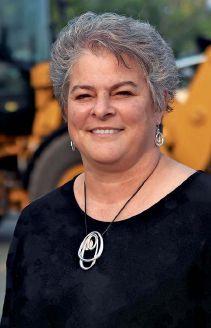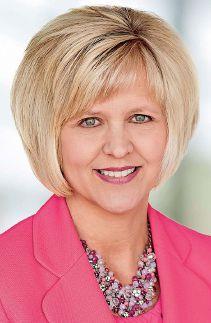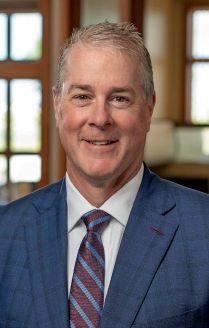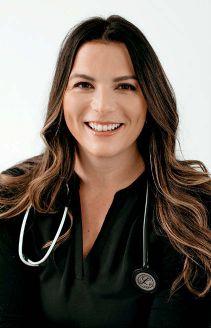
4 minute read
Q.INSIGHTs & INTUITION

In what ways does your business give back to the community?
Twylah Blotsky President & CEO Butler Machinery Fargo, N.D.

The Butler leadership team values stewardship of communities across our region. We set examples by giving back to these communities and believe that support through time and donations helps organizations grow together and strengthens character through building relationships and putting others before self. Butler offers a generous associate volunteer program to provide our team opportunities to support organizations of their choosing.
I remain professionally engaged in the equipment industry, serving on the Lignite Energy Council Board of Directors and the Pioneer Equipment Dealer Association, and personally through organizations such as the Theodore Roosevelt Medora Foundation and the Ralph Englestad Arena.
The Northern Lights Council Boy Scouts of America is close to my heart, and I have been an active member at the pack and troop levels since 2002, continue to serve on a variety of council committees and was fortunate to receive the Corporate Community Service Award in 2018. We are a proud member of the United Way’s Tocqueville Society, and our team promotes United Way campaigns annually at the store level. The Butler team’s charitable giving also includes support to local FFA chapters across our region, local fire departments, veterans, and other impactful organizations across our Midwest territory.
Like so many generous companies in our region, Bell Bank believes strongly in giving back to the community. One of our core values is “paying it forward by giving back to the communities we serve,” because we know our customers and friends are the reason for our success.
Bell Bank has a unique Pay It Forward initiative that inspires all of us – and we’re proud that it has inspired other organizations around the country as well.

Every year, every full-time employee at Bell receives $1,000 and every part-time employee $500 to pay it forward as they choose to individuals, families or organizations in need. (In celebration of our milestone of reaching $10 billion in assets, our generous owners increased this to $5,000 for full-time employees and $2,500 for part-time employees, in 2022-23.)
This program has opened all of our eyes to the needs around us, and it is part of what motivates our team members to come to work every day with “pay it forward hearts” ready to help others. To date, Pay It Forward has empowered more than $21 million in giving where our employees see the greatest need.
Julie Peterson Klein EVP/Chief of Staff and Chief Culture Officer Bell Bank Fargo, N.D.

We value our role as neighbors and contributors. The Cornerstone Bank team lives this value day in and day out. Our team members are experienced in helping their local community through their work at the bank. They know what local businesses are facing and how economic booms come and go. Through our needs-based approach, Cornerstone Bank team members work to find the best possible financial options.
Our team members are also very experienced in the local community outside of the bank. We’re trusted beyond banking because we’ve lived in our communities for generations, and we’re more than experienced people – we’re people who will do what it takes to help our neighbors thrive. Our team members are very active in their communities in leadership positions for local organizations; on ambulance squads and fire departments; as mentors; through volunteering for youth programs; by working on community beautification; and in many other roles. The amount of hours that our team puts into giving back to the community is staggering.
Cornerstone Bank also has a Matching Gifts program where we match team member donations to local charities. We are proud to support the charities that our team members support.
Jeff Thomas President/Chief Executive Officer Cornerstone Bank Fargo, N.D.


Owner, Founder WELL & Company Alexandria, Minn.
WELL & Company’s commitment to the community is evidenced through providing price transparency and high-quality health care. The health care landscape is continually changing and the importance of being an informed consumer is essential. From the beginning, WELL & Company has been a direct reflection of our own community’s needs – offering membership opportunities for both individuals and families, as well as small businesses who desire to offer an alternative to traditional insurance for their employees. Additionally, our belief that every individual deserves quality health care is the reason behind our Charitable Care program, which is offered to patients undergoing financial strain.
As a small business in a growing community we recognize the importance of pouring into upcoming generations of professionals. Partnering with our local high school, we partake in a CAPS Program (Center for Advanced Professional Studies), through which we are able to immerse students in real-world learning experiences in our professional clinic and medical spa settings. Different seasons bring different opportunities to give back to the community and we hold those to the highest regard. Being able to invest in the people that support and sustain us is humbling, to say the least.

ESTABLISHMENTS, VACCINATIONS AND INCENTIVES
COVID-19 vaccinations were required for some or all employees before coming to work onsite at 17.5% of U.S. establishments. Among these establishments, 45.9% offered vaccination incentives to their employees. Among establishments with 1 to 4 employees, 40.8% offered vaccination incentives. By comparison, more than three-fourths of the largest establishments (500 to 999 employees and 1,000 employees or more) that required vaccinations to work onsite offered vaccine incentives.
Workers With Disabilities

The employment–population ratio – the percentage of the population that is employed – for people with a disability was 19.1% in 2021. That was an increase of 1.2 percentage points from 2020. The ratio for those without a disability, at 63.7% in 2021, increased by 1.9 percentage points over the year. Data for both groups reflect the impact of the COVID-19 pandemic on the labor market. The lower ratio among people with a disability reflects, in part, the older age profile of people with a disability; older people are less likely to be employed regardless of disability status.
Women In Health Care
Source: U.S. Bureau of Labor Statistics
In 2021, 16.4 million women were employed in the health care and social assistance industry. This was 77.6% of the total 21.2 million workers in the industry. Looking at the component industries that make up health care and social assistance, women counted for 75% of total employment (5.2 million) in hospitals, 77.4% of total employment (8.3 million) in health services, except hospitals, and 84% of total employment (2.6 million) in social assistance.
Workers With Disabilities 2
The unemployment rates for persons with and without a disability both declined from 2020 to 2021, to 10.1% and 5.1%, respectively.
Source: U.S. Bureau of Labor Statistics











